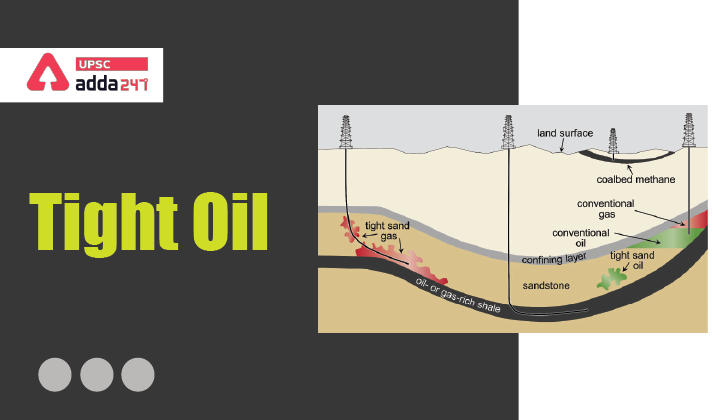Table of Contents
Shale Gas: Relevance
- GS 3: Infrastructure: Energy, Ports, Roads, Airports, Railways etc.
Shale Gas: Context
- Recently, Cairn Oil & Gas has announced that it is collaborating with US-based Halliburton to start shale exploration in the Lower Barmer Hill formation, Rajasthan.
What is Shale Gas or Tight oil?
- Shale Gas meaning: Tight oil is a type of oil found in impermeable shale and limestone rock deposits.
- Shale Gas extraction: Also known as “shale oil,” tight oil is processed into gasoline, diesel, and jet fuels—just like conventional oil—but is extracted using hydraulic fracturing, or “fracking.”
Shale Gas Vs Crude Oil
- The key difference between shale oil and conventional crude is that the former is found in smaller batches, and deeper than conventional crude deposits.
- The shale gas extraction requires creation of fractures in oil and gas rich shale to release hydrocarbons through a process called hydraulic fracking.
Shale Gas production
- Russia and the US are among the largest shale oil producers in the world.
- The shale gas production in US, however, has played a key role in turning the country from an importer of crude to a net exporter in 2019.
Shale Gas composition
- Shale Gas are rich in organic material (0.5% to 25%), and are usually mature petroleum source rocks in the thermogenic gas window, where high heat and pressure have converted petroleum to natural gas.
- They are sufficiently brittle and rigid enough to maintain open fractures.
- Shale gas also includes condensates and water.
- The gaseous components of raw shale gas include sulfur dioxide, hydrogen sulfide, helium, nitrogen, and carbon dioxide.
- Mercury may also be found in smaller concentrations in most reservoirs where natural gas is obtained.
Shale Gas in India
- As of now, there is no large-scale commercial production of shale oil and gas in India.
- In 2013, ONGC (Oil and Natural Gas Corporation) started exploration.
- ONGC’s assessed shale oil at the Cambay basin in Gujarat and the Krishna Godavari basin in Andhra Pradesh.
- ONGC concluded that “the quantity of oil flow observed in these basins” did not indicate “commerciality” and that the general characteristics of Indian shales are quite different from North American ones.
Shale Gas extraction challenges
- ONGC has reduced investments over the past few years after only getting limited success in shale exploration efforts.
- The technology to collect and market the natural gas is available, but rather than installing the necessary infrastructure, companies often burn excess gas at the well site, selling just the liquid fossil fuels.
- Known as flaring, this process substantially increases the global warming emissions associated with shale oil (flaring is so extensive in some areas that North Dakota’s flaring sites can be seen from space).
- Fugitive methane emissions—which occur when natural gas is leaked or vented—are another avoidable climate change contributor.
- Tight oil has significant impact on water, air, and noise pollution around drilling sites, and the risk of oil spills by the trucks, trains, and pipes that transport extracted shale oil to refineries.
Also Read:
| India-Russia Energy Cooperation | State Energy Efficiency Index (SEEI) 2020 | World Energy Outlook 2021 | Status Renewable Energy in India |
| International Energy Agency | India-US Clean Energy Agenda 2030 Partnership | Renewable Energy Land Use in India | International Atomic Energy Agency (IAEA) |





 TSPSC Group 1 Question Paper 2024, Downl...
TSPSC Group 1 Question Paper 2024, Downl...
 TSPSC Group 1 Answer key 2024 Out, Downl...
TSPSC Group 1 Answer key 2024 Out, Downl...
 UPSC Prelims 2024 Question Paper, Downlo...
UPSC Prelims 2024 Question Paper, Downlo...




